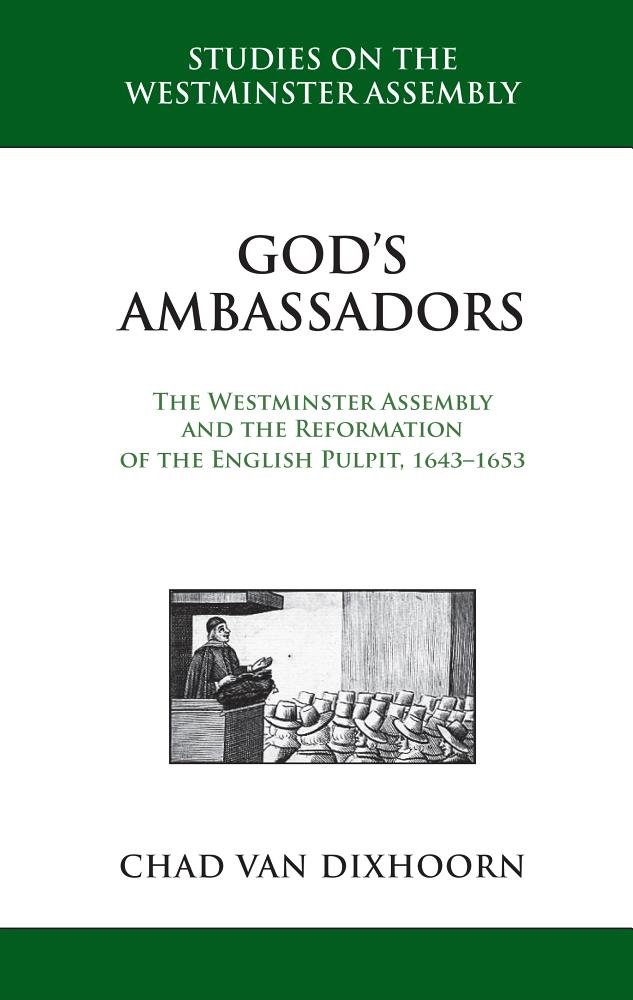Reviewed by Andrew Ballitch
Summary and Review
The Puritans who assembled in the Jerusalem Chamber of Westminster Abbey, during one of the most tumultuous decades of England’s history, had a favorite metaphor they used for preachers: ambassadors. They found the metaphor in Scripture, of course, and just as an ambassador can faithfully deliver the communication of a king, so can the preacher relay the message of God. The enormity and gravity of the task had wide-ranging implications for the preacher, his preparation, and the execution of his office. England’s preaching ministry, while a Puritan priority from the beginning, quickly became the Westminster Assembly’s preoccupation. Chad Van Dixhoorn’s study, for the first time, highlights “the extent to which the assembly went in promoting godly preaching and improved preaching” (173). His purpose is to “describe the reformation that the assembly effected and the pulpit theology of its members” (175). And as the editor of the five-volume collection of minutes and papers of the Westminster Assembly, he is beyond qualified to do so.
Van Dixhoorn’s presentation includes three main sections. First, he puts the whole discussion in its historical context. Chapter 1 shows the close relationship of the assembly to Puritanism. Here we also encounter the book’s primary thesis: “the real story is not that people preached differently because of the Westminster Assembly but that different people were preaching. Preaching was reformed, in the main, by changing the preachers” (10). Chapter 2 places the assembly in the narrative of the Reformed tradition, specifically in its English manifestation. There existed an established godly tradition that valued preaching for the sake of the church as the ordinary means for salvation. Chapter 3 then describes the political environment. William Laud was key in this period of history. Leading up to the decade of interest, Archbishop Laud and his suspected Roman Catholicism were together the most significant enemy in the Puritan mind. Once the civil war began, focus necessarily shifted to the explosion of sectarian preaching. One aspect missing from the historical sketch provided is the significant improvement of ministerial preparation under Elizabeth and James through education and informal training.
Second, Van Dixhoorn addresses the assembly’s mechanism for reforming the English pulpit. The effort was to purge and purify. Chapter 4 outlines the assembly’s approach, namely, conducting examinations itself. The examination of new preachers and those looking to change church assignments was continued until the assembly was disbanded. Chapters 5, 6, and 7 highlight some of the debates within the assembly and provide an exposition of the Directories for Ordination and Public Worship. What becomes clear is that the Westminster divines were committed to a learned and godly ministry. The examination system as a solution, however, meant that the assembly’s improvements were a short-term fix. Removal instead of renewal resulted in long-term failure as the strategy only worked under the contemporary political and ecclesiastical arrangement, both of which were definitively reversed at the Restoration in 1660.
Finally, Van Dixhoorn expounds the divines’ pulpit theology, the reasoning behind the assembly’s writings and agenda. Chapter 8 paints the ideal preacher, one who is godly, trained, and ordained. Chapters 9 through 12 focus on preaching itself. For members of the assembly, preaching the word of God was the ordinary means of grace. As God-ordained means, sermons were to be prepared by the preacher delivering them and presence during the act of preaching was essential for God’s people. Preaching should be Christ-centered, undergirded by Christ-centered exegesis. So Scripture was interpreted theologically and typologically. Van Dixhoorn properly recognizes the distinction between seventeenth-century Puritan exegesis and strictly historical, literal, and grammatical models so prevalent in modern exegesis. Chapter 13 finishes the book by noting that, for the assembly members, there was no contradiction between reliance on the Holy Spirit and study.
God’s Ambassadors comes out of an impressive breadth of research. It is a collection of fascinating snapshots, but it lacks clear internal coherence. Some chapters seem underdeveloped, with information presented at times in the absence of analysis. While the unity of the work is described in the preface and conclusion, it would aid readers if the argument were more explicit throughout. That said, there is much here from which both readers in the academy and church will benefit from. Interest to scholars of early modern Britain and the Reformed tradition in the seventeenth-century is perhaps obvious. But there is practical relevance for the church as well. Certainly there are insights to be gleaned about preaching and pastoral ministry from a gathering of ministers like the Westminster Assembly, who combined their powers to articulate an ideal for preachers and preaching and who examined 5,000 candidates. Two such insights, which Van Dixhoorn helpfully highlights, are one, a theology of preaching that recognizes it as the ordinary means of grace that God extraordinarily blesses, and two, the importance of training and ordaining. Application of these insights would leaven the church’s view of preaching and preachers in the twenty-first century.
Andrew Ballitch is a pastor at Hunsinger Lane Baptist Church in Louisville, Kentucky. He holds a PhD in church history and historical theology from Southern Baptist Theological Seminary.
